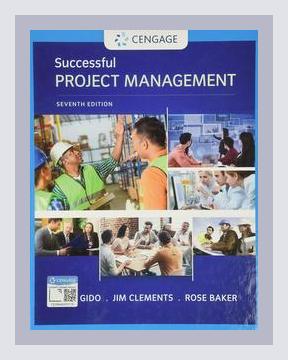Operations and Supply Chain ManagementQuality Control
Introduction
“Successful Project Management” offers a comprehensive guide to managing projects effectively, with a focus on quality control and strategic planning. The book is structured to provide actionable insights and concrete examples that facilitate the practical application of its principles.
Chapter 1: Introduction to Project Management
The authors introduce project management as a deliberate and organized venture to achieve specific objectives. They emphasize the importance of defining clear project objectives and the vital role of project managers.
- Actionable Tip: Clearly Define Objectives
- Example: A project manager overseeing the development of a new software should define specific goals such as “Increase user engagement by 20% within six months.”
Chapter 2: Project Selection and Prioritization
This chapter covers the strategies for selecting and prioritizing projects, stressing alignment with organizational goals and resource availability.
- Actionable Tip: Use a Weighted Scoring Model
- Example: When choosing between potential projects, apply criteria such as potential ROI, alignment with company strategy, and resource requirements. Assign weights to each criterion and score each project to identify the best option.
Chapter 3: Organizational Capability: Structure, Culture, and Roles
The authors discuss the influence of organizational structure and culture on project success, highlighting the need for alignment between project methods and organizational norms.
- Actionable Tip: Align Project Methods with Organizational Culture
- Example: In a company with a collaborative culture, use team-based project management approaches. Foster open communication and regular team meetings to ensure alignment.
Chapter 4: Project Planning: PERT and CPM
This section delves into planning tools such as the Program Evaluation Review Technique (PERT) and the Critical Path Method (CPM), which are useful for scheduling and managing project timelines.
- Actionable Tip: Create a Detailed Project Schedule Using CPM
- Example: For a construction project, identify the critical tasks and map them on a timeline to ensure timely completion. Use CPM to manage dependencies and critical paths effectively.
Chapter 5: Budgeting the Project
Budgeting is vital for project management. The authors highlight methods for accurate budget estimation and control to keep projects within financial constraints.
- Actionable Tip: Develop a Detailed Budget Using Bottom-Up Estimation
- Example: Break down project activities, estimate costs for each at the micro-level, and then aggregate these to create a comprehensive budget. Include contingency funds for unforeseen expenses.
Chapter 6: Project Risk Management
Risk management is about identifying, analyzing, and addressing potential risks. The authors outline a systematic approach to handle risks, including risk assessment and mitigation strategies.
- Actionable Tip: Conduct a Risk Assessment Workshop
- Example: Organize a session with stakeholders to identify potential risks, evaluate their impact and likelihood, and develop mitigation strategies for each identified risk.
Chapter 7: Communication Skills
Effective communication is crucial for project success. The chapter emphasizes the importance of clear, consistent, and continuous communication among all project stakeholders.
- Actionable Tip: Implement a Stakeholder Communication Plan
- Example: Develop a plan that specifies what information will be communicated, who will communicate it, the methods of communication, and the frequency. This ensures transparency and keeps all stakeholders informed.
Chapter 8: Managing Project Teams
The authors discuss strategies for building and managing project teams, focusing on team dynamics, motivation, and conflict resolution.
- Actionable Tip: Conduct Team-Building Activities
- Example: Workshops, team lunches, and collaborative exercises can enhance trust and cooperation. Use these activities to build a cohesive team that works well together.
Chapter 9: Project Quality Management
Ensuring project quality is discussed through processes like quality planning, quality assurance, and quality control, with a focus on meeting customer expectations and standards.
- Actionable Tip: Establish Quality Metrics Early
- Example: Define quality standards and metrics at the start of the project. Use tools like checklists and audits to regularly check project outputs against these standards.
Chapter 10: Project Procurement Management
This chapter highlights the procurement process, including planning, vendor selection, and contract management to ensure that all project resources are effectively and efficiently acquired.
- Actionable Tip: Develop a Procurement Management Plan
- Example: Outline procurement requirements, timelines, vendor selection criteria, and contract terms. This plan ensures all procurements align with project needs and timelines.
Chapter 11: Project Progress and Performance Measurement and Evaluation
The authors address techniques for monitoring project progress and performance, emphasizing the need for regular evaluations and adjustments.
- Actionable Tip: Use Earned Value Management (EVM) Metrics
- Example: Track project performance by calculating metrics such as Schedule Performance Index (SPI) and Cost Performance Index (CPI). Regularly compare these against baselines to identify variances and take corrective actions.
Chapter 12: Closing the Project
The final steps in project management involve ensuring all project goals have been met and formally closing the project. This chapter provides a methodology for documenting lessons learned and celebrating achievements.
- Actionable Tip: Conduct a Project Closeout Meeting
- Example: Gather the team to review what worked well and what didn’t. Document these lessons for future reference and celebrate the team’s achievements to boost morale for upcoming projects.
Conclusion
“Successful Project Management” armors readers with a systematic approach to managing projects effectively. By applying the provided actionable tips and utilizing the discussed tools and methodologies, project managers can enhance their efficiency and project success rates. The book’s emphasis on aligning projects with organizational goals, meticulous planning, risk management, and quality control forms the essence of a structured project management process.
